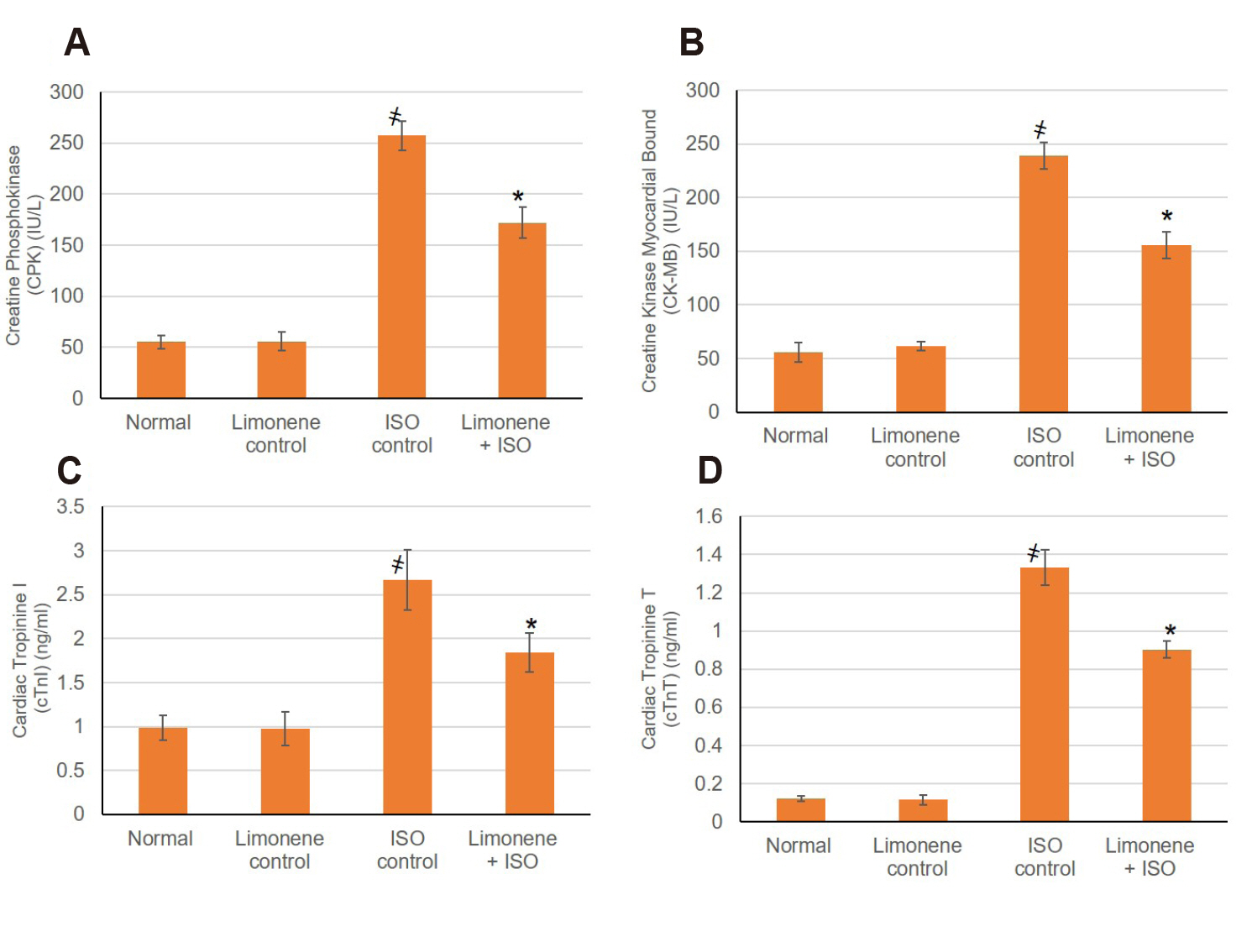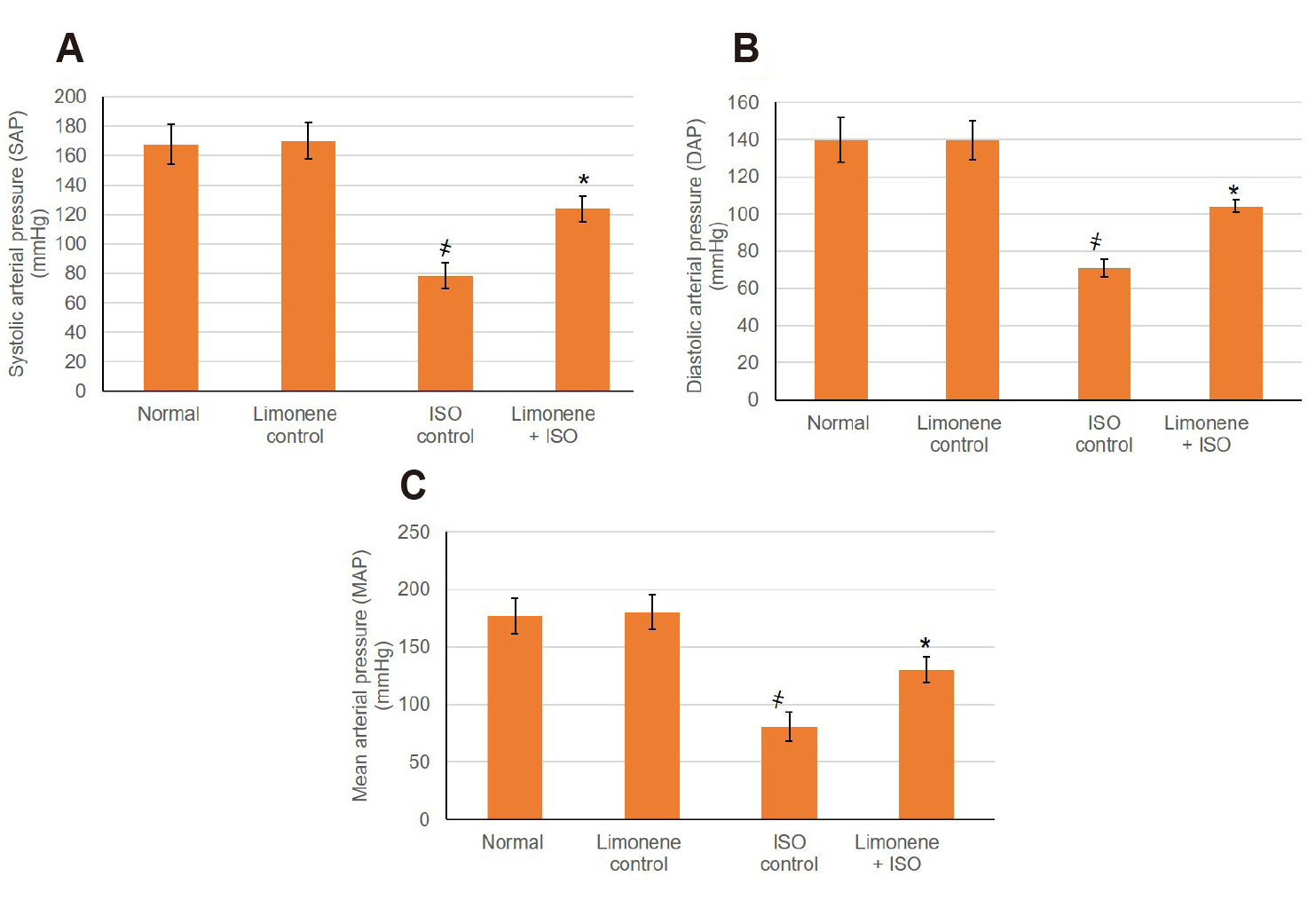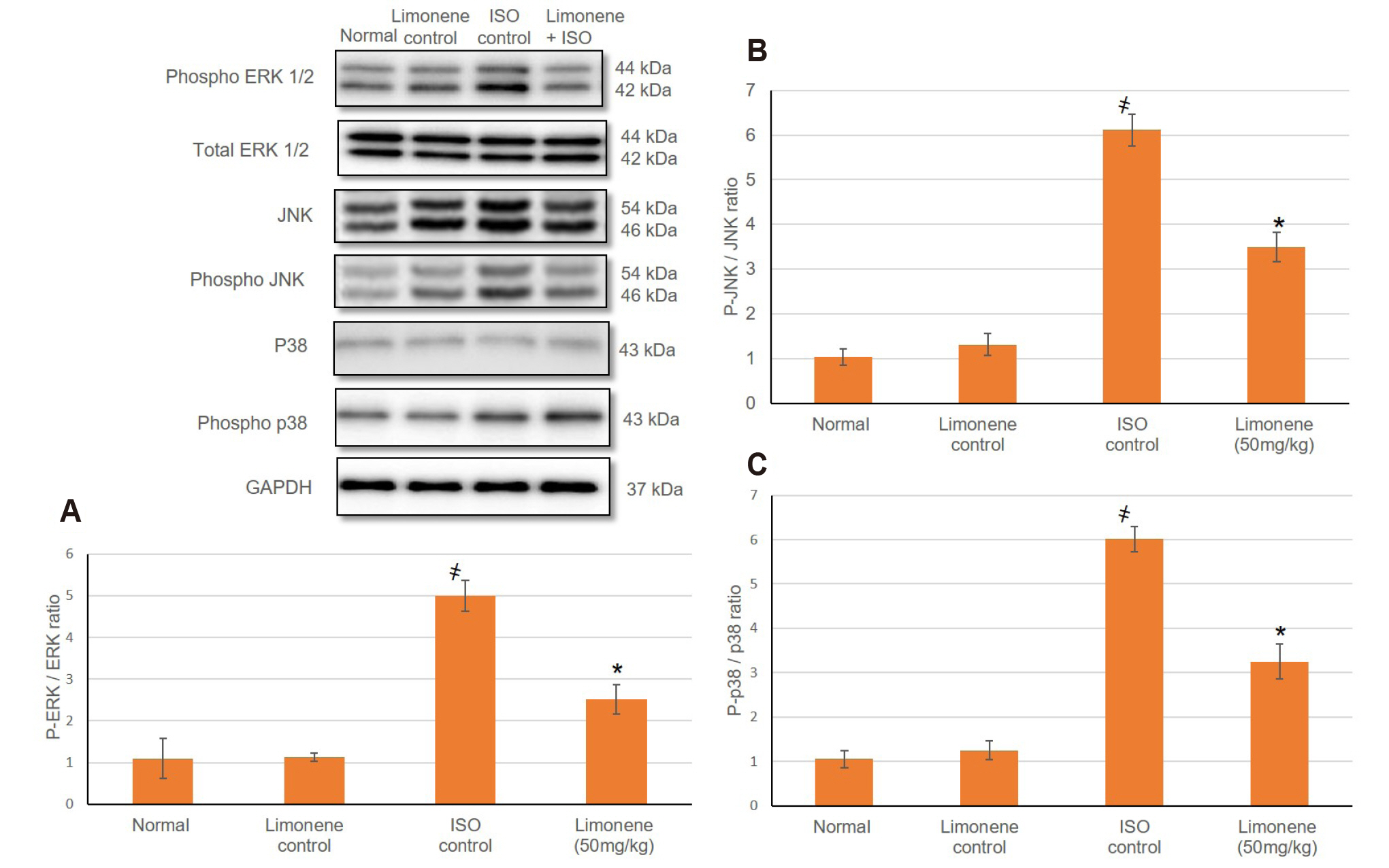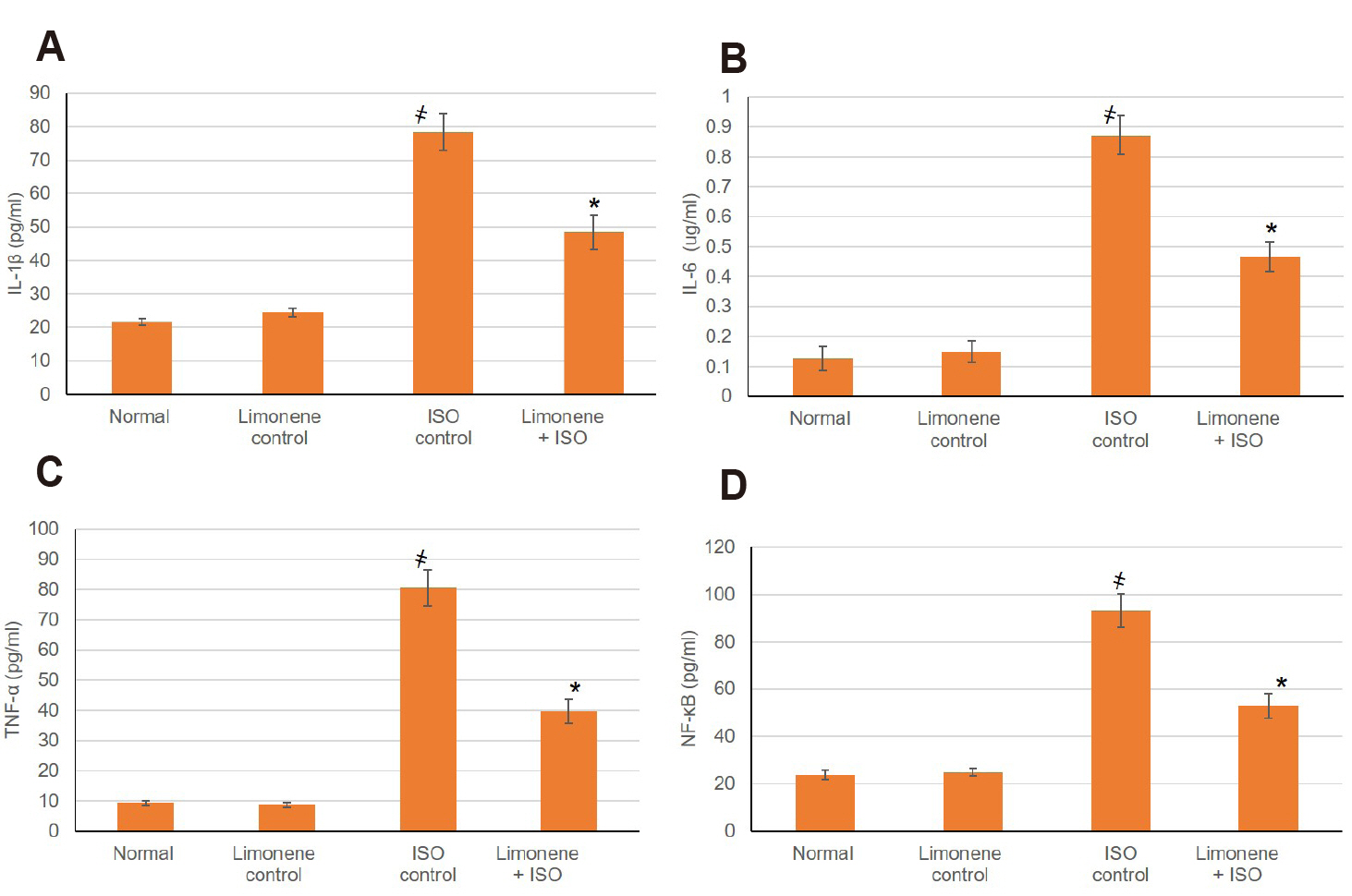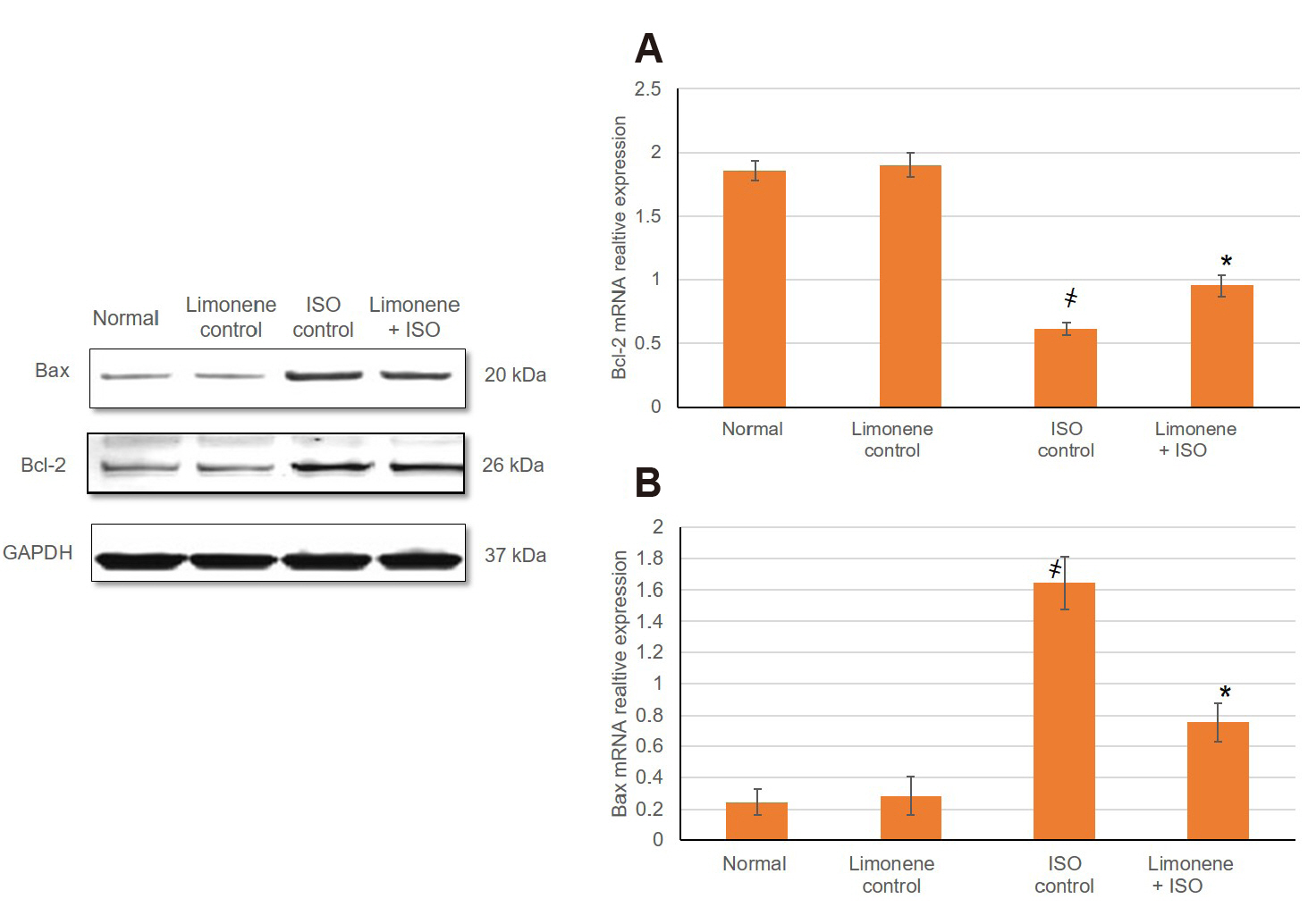Korean J Physiol Pharmacol.
2020 May;24(3):259-266. 10.4196/kjpp.2020.24.3.259.
D-Limonene mitigate myocardial injury in rats through MAPK/ ERK/NF-κB pathway inhibition
- Affiliations
-
- 1Department of Pharmaceutical Sciences, College of Clinical Pharmacy, King Faisal University, Al-Hasa 31982, Kingdom of Saudi Arabia
- 2Department of Pharmacology, Zagazig University, Zagazig 44519, Egypt
- KMID: 2502508
- DOI: http://doi.org/10.4196/kjpp.2020.24.3.259
Abstract
- Cardiovascular diseases are the primary reason of mortality, among which myocardial infarction (MI) is the most dominant and prevalent. This study was considered to examine D-Limonene protective action against isoproterenol (ISO) induced MI. Wister male rats were dispersed into four groups. Normal and D-Limonene control group in which rats administered saline or D-Limonene. ISO control animals were administered saline for 21 days then challenged with ISO (85 mg/kg, subcutaneously) on 20th and 21st day for MI induction. D-Limonene pretreated group in which animals were pretreated with D-Limonene 50 mg/kg orally for 21 days then administered ISO on 20th and 21st day. MI prompted variations were assessed by myocardial infarction area determination, blood pressure (BP) alterations, cardiac injury biomarkers and inflammatory mediators measurements. For more depth investigation, both the apoptotic status was evaluated via measuring mRNA expression of Bcl-2 and Bax as well as mitogen-activated protein kinase-extracellular signal-regulated kinase (MAPK-ERK) signal transduction were investigated via Western blotting. MI group revealed significant infarcted area, blood pressure alterations, myocardial injury enzymes intensification together with inflammatory cytokines amplification. MI was associated with activation of MAPK-ERK signal pathway and apoptotic status within the myocardium. On the other hand, pretreated with D-Limonene demonstrated deterred infracted area, reduced myocardial enzymes, improved BP indices, lessened inflammatory levels. Furthermore, D-Limonene pretreatment caused a decline in MAPK proteins pathway and Bax relative mRNA expression, while intensifying Bcl-2 mRNA expression promoting that D-Limonene may constrain MI induced myocardial apoptosis. D-Limonene mitigated MI injury through MAPK/NF-κB pathway inhibition and anti-apoptotic effect.
Keyword
Figure
Reference
-
1. Sun J. 2007; D-Limonene: safety and clinical applications. Altern Med Rev. 12:259–264. PMID: 18072821.2. de Souza MC, Vieira AJ, Beserra FP, Pellizzon CH, Nóbrega RH, Rozza AL. 2019; Gastroprotective effect of limonene in rats: influence on oxidative stress, inflammation and gene expression. Phytomedicine. 53:37–42. DOI: 10.1016/j.phymed.2018.09.027. PMID: 30668410.
Article3. Kummer R, Fachini-Queiroz FC, Estevão-Silva CF, Grespan R, Silva EL, Bersani-Amado CA, Cuman RK. 2013; Evaluation of anti-inflammatory activity of citrus latifolia tanaka essential oil and limonene in experimental mouse models. Evid Based Complement Alternat Med. 2013:859083. DOI: 10.1155/2013/859083. PMID: 23762165. PMCID: PMC3671226.4. Hirota R, Roger NN, Nakamura H, Song HS, Sawamura M, Suganuma N. 2010; Anti-inflammatory effects of limonene from yuzu (Citrus junos Tanaka) essential oil on eosinophils. J Food Sci. 75:H87–92. DOI: 10.1111/j.1750-3841.2010.01541.x. PMID: 20492298.5. Rufino AT, Ribeiro M, Sousa C, Judas F, Salgueiro L, Cavaleiro C, Mendes AF. 2015; Evaluation of the anti-inflammatory, anti-catabolic and pro-anabolic effects of E-caryophyllene, myrcene and limonene in a cell model of osteoarthritis. Eur J Pharmacol. 750:141–150. DOI: 10.1016/j.ejphar.2015.01.018. PMID: 25622554.
Article6. d'Alessio PA, Ostan R, Bisson JF, Schulzke JD, Ursini MV, Béné MC. 2013; Oral administration of D-limonene controls inflammation in rat colitis and displays anti-inflammatory properties as diet supplementation in humans. Life Sci. 92:1151–1156. DOI: 10.1016/j.lfs.2013.04.013. PMID: 23665426.7. Yu L, Yan J, Sun Z. 2017; D-limonene exhibits anti-inflammatory and antioxidant properties in an ulcerative colitis rat model via regulation of iNOS, COX-2, PGE2 and ERK signaling pathways. Mol Med Rep. 15:2339–2346. DOI: 10.3892/mmr.2017.6241. PMID: 28260017.
Article8. Murali R, Karthikeyan A, Saravanan R. 2013; Protective effects of D-limonene on lipid peroxidation and antioxidant enzymes in streptozotocin-induced diabetic rats. Basic Clin Pharmacol Toxicol. 112:175–181. DOI: 10.1111/bcpt.12010. PMID: 22998493.9. Roberto D, Micucci P, Sebastian T, Graciela F, Anesini C. 2010; Antioxidant activity of limonene on normal murine lymphocytes: relation to H2O2 modulation and cell proliferation. Basic Clin Pharmacol Toxicol. 106:38–44. DOI: 10.1111/j.1742-7843.2009.00467.x. PMID: 19796276.10. Bai J, Zheng Y, Wang G, Liu P. 2016; Protective effect of D-limonene against oxidative stress-induced cell damage in human lens epithelial cells via the p38 pathway. Oxid Med Cell Longev. 2016:5962832. DOI: 10.1155/2016/5962832. PMID: 26682012. PMCID: PMC4670880.
Article11. Ahmad S, Beg ZH. 2013; Hypolipidemic and antioxidant activities of thymoquinone and limonene in atherogenic suspension fed rats. Food Chem. 138:1116–1124. DOI: 10.1016/j.foodchem.2012.11.109. PMID: 23411222.
Article12. Piccinelli AC, Morato PN, Dos Santos Barbosa M, Croda J, Sampson J, Kong X, Konkiewitz EC, Ziff EB, Amaya-Farfan J, Kassuya CA. 2017; Limonene reduces hyperalgesia induced by gp120 and cytokines by modulation of IL-1β and protein expression in spinal cord of mice. Life Sci. 174:28–34. DOI: 10.1016/j.lfs.2016.11.017. PMID: 27888114.13. Panaskar SN, Joglekar MM, Taklikar SS, Haldavnekar VS, Arvindekar AU. 2013; Aegle marmelos Correa leaf extract prevents secondary complications in streptozotocin-induced diabetic rats and demonstration of limonene as a potent antiglycating agent. J Pharm Pharmacol. 65:884–894. DOI: 10.1111/jphp.12044. PMID: 23647682.14. Ahmad SB, Rehman MU, Fatima B, Ahmad B, Hussain I, Ahmad SP, Farooq A, Muzamil S, Razzaq R, Rashid SM, Ahmad Bhat S, Mir MUR. 2018; Antifibrotic effects of D-limonene (5(1-methyl-4-[1-methylethenyl]) cyclohexane) in CCl4 induced liver toxicity in Wistar rats. Environ Toxicol. 33:361–369. DOI: 10.1002/tox.22523. PMID: 29251412.15. Lappas CM, Lappas NT. 2012; D-Limonene modulates T lymphocyte activity and viability. Cell Immunol. 279:30–41. DOI: 10.1016/j.cellimm.2012.09.002. PMID: 23059811.
Article16. Yoon M. 2009; The role of PPARalpha in lipid metabolism and obesity: focusing on the effects of estrogen on PPARalpha actions. Pharmacol Res. 60:151–159. DOI: 10.1016/j.phrs.2009.02.004. PMID: 19646654.17. Victor Antony Santiago J, Jayachitra J, Shenbagam M, Nalini N. 2012; Dietary d-limonene alleviates insulin resistance and oxidative stress-induced liver injury in high-fat diet and L-NAME-treated rats. Eur J Nutr. 51:57–68. DOI: 10.1007/s00394-011-0182-7. PMID: 21445622.
Article18. Moraes TM, Rozza AL, Kushima H, Pellizzon CH, Rocha LR, Hiruma-Lima CA. 2013; Healing actions of essential oils from Citrus aurantium and d-limonene in the astric mucosa: the roles of VEGF, PCNA, and COX-2 in cell proliferation. J Med Food. 16:1162–1167. DOI: 10.1089/jmf.2012.0259. PMID: 24328705.19. Hassan MQ, Akhtar MS, Akhtar M, Ali J, Haque SE, Najmi AK. 2016; Edaravone, a potent free radical scavenger and a calcium channel blocker attenuate isoproterenol induced myocardial infarction by suppressing oxidative stress, apoptotic signaling and ultrastructural damage. Ther Adv Cardiovasc Dis. 10:214–223. DOI: 10.1177/1753944716630653. PMID: 26868288. PMCID: PMC5942626.
Article20. Lu L, Liu M, Sun R, Zheng Y, Zhang P. 2015; Myocardial infarction: symptoms and treatments. Cell Biochem Biophys. 72:865–867. DOI: 10.1007/s12013-015-0553-4. PMID: 25638347.
Article21. Verma VK, Malik S, Narayanan SP, Mutneja E, Sahu AK, Bhatia J, Arya DS. 2019; Role of MAPK/NF-κB pathway in cardioprotective effect of Morin in isoproterenol induced myocardial injury in rats. Mol Biol Rep. 46:1139–1148. DOI: 10.1007/s11033-018-04575-9. PMID: 30666500.
Article22. Ren GD, -Y Cui Y, Li WL, Li FF, Han XY. 2019; Research on cardioprotective effect of irbesartan in rats with myocardial ischemia-reperfusion injury through MAPK-ERK signaling pathway. Eur Rev Med Pharmacol Sci. 23:5487–5494. DOI: 10.26355/eurrev_201906_18218. PMID: 31298402.23. Bi F, Xu Y, Sun Q. 2018; Catalpol pretreatment attenuates cardiac dysfunction following myocardial infarction in rats. Anatol J Cardiol. 19:296–302. DOI: 10.14744/AnatolJCardiol.2018.33230. PMID: 29724983. PMCID: PMC6280265.24. Li L, Zhang LK, Pang YZ, Pan CS, Qi YF, Chen L, Wang X, Tang CS, Zhang J. 2006; Cardioprotective effects of ghrelin and des-octanoyl ghrelin on myocardial injury induced by isoproterenol in rats. Acta Pharmacol Sin. 27:527–535. DOI: 10.1111/j.1745-7254.2006.00319.x. PMID: 16626506.25. Younis NS, Mohamed ME. 2019; β-caryophyllene as a potential protective agent against myocardial injury: the role of toll-like receptors. Molecules. 24:E1929. DOI: 10.3390/molecules24101929. PMID: 31109132. PMCID: PMC6572120.
Article26. Liu K, Li M, Ren X, You QS, Wang F, Wang S, Ma CH, Li WN, Ye Q. 2019; Huang Qi Tong Bi Decoction attenuates myocardial ischemia-reperfusion injury via HMGB1/TLR/NF-κB pathway. Mediators Inflamm. 2019:8387636. DOI: 10.1155/2019/8387636. PMID: 30944548. PMCID: PMC6421754.27. Shahzad S, Mateen S, Naeem SS, Akhtar K, Rizvi W, Moin S. 2019; Syringic acid protects from isoproterenol induced cardiotoxicity in rats. Eur J Pharmacol. 849:135–145. DOI: 10.1016/j.ejphar.2019.01.056. PMID: 30731086.
Article28. Wang N, Guan P, Zhang JP, Li YQ, Chang YZ, Shi ZH, Wang FY, Chu L. 2011; Fasudil hydrochloride hydrate, a Rho-kinase inhibitor, suppresses isoproterenol-induced heart failure in rats via JNK and ERK1/2 pathways. J Cell Biochem. 112:1920–1929. DOI: 10.1002/jcb.23112. PMID: 21433064.
Article29. Liu K, Wang F, Wang S, Li WN, Ye Q. 2019; Mangiferin attenuates myocardial ischemia-reperfusion injury via MAPK/Nrf-2/HO-1/NF-κB in vitro and in vivo. Oxid Med Cell Longev. 2019:7285434. DOI: 10.1155/2019/7285434. PMID: 31249649. PMCID: PMC6535818.
Article30. Krishnamurthy P, Subramanian V, Singh M, Singh K. 2007; Beta1 integrins modulate beta-adrenergic receptor-stimulated cardiac myocyte apoptosis and myocardial remodeling. Hypertension. 49:865–872. DOI: 10.1161/01.HYP.0000258703.36986.13. PMID: 17283249.31. Rehman MU, Tahir M, Khan AQ, Khan R, Oday-O-Hamiza , Lateef A, Hassan SK, Rashid S, Ali N, Zeeshan M, Sultana S. 2014; D-limonene suppresses doxorubicin-induced oxidative stress and inflammation via repression of COX-2, iNOS, and NFκB in kidneys of Wistar rats. Exp Biol Med (Maywood). 239:465–476. DOI: 10.1177/1535370213520112. PMID: 24586096.
Article32. Tang XP, Guo XH, Geng D, Weng LJ. 2019; d-Limonene protects PC12 cells against corticosterone-induced neurotoxicity by activating the AMPK pathway. Environ Toxicol Pharmacol. 70:103192. DOI: 10.1016/j.etap.2019.05.001. PMID: 31103492.
Article33. Chi G, Wei M, Xie X, Soromou LW, Liu F, Zhao S. 2013; Suppression of MAPK and NF-κB pathways by limonene contributes to attenuation of lipopolysaccharide-induced inflammatory responses in acute lung injury. Inflammation. 36:501–511. DOI: 10.1007/s10753-012-9571-1. PMID: 23180366.
Article
- Full Text Links
- Actions
-
Cited
- CITED
-
- Close
- Share
- Similar articles
-
- Neogambogic acid relieves myocardial injury induced by sepsis via p38 MAPK/NF-κB pathway
- Triptolide improves myocardial fibrosis in rats through inhibition of nuclear factor kappa B and NLR family pyrin domain containing 3 inflammasome pathway
- Treadmill Running Improves Spatial Learning Memory Through Inactivation of Nuclear Factor Kappa B/Mitogen-Activated Protein Kinase Signaling Pathway in Amyloid-β-Induced Alzheimer Disease Rats
- Kaempferol Regulates the Expression of Airway MUC5AC Mucin Gene via IκBα-NF-κB p65 and p38-p44/42-Sp1 Signaling Pathways
- Galangin Regulates Mucin 5AC Gene Expression via the Nuclear Factor-κB Inhibitor α/Nuclear Factor-κB p65 Pathway in Human Airway Epithelial Cells


